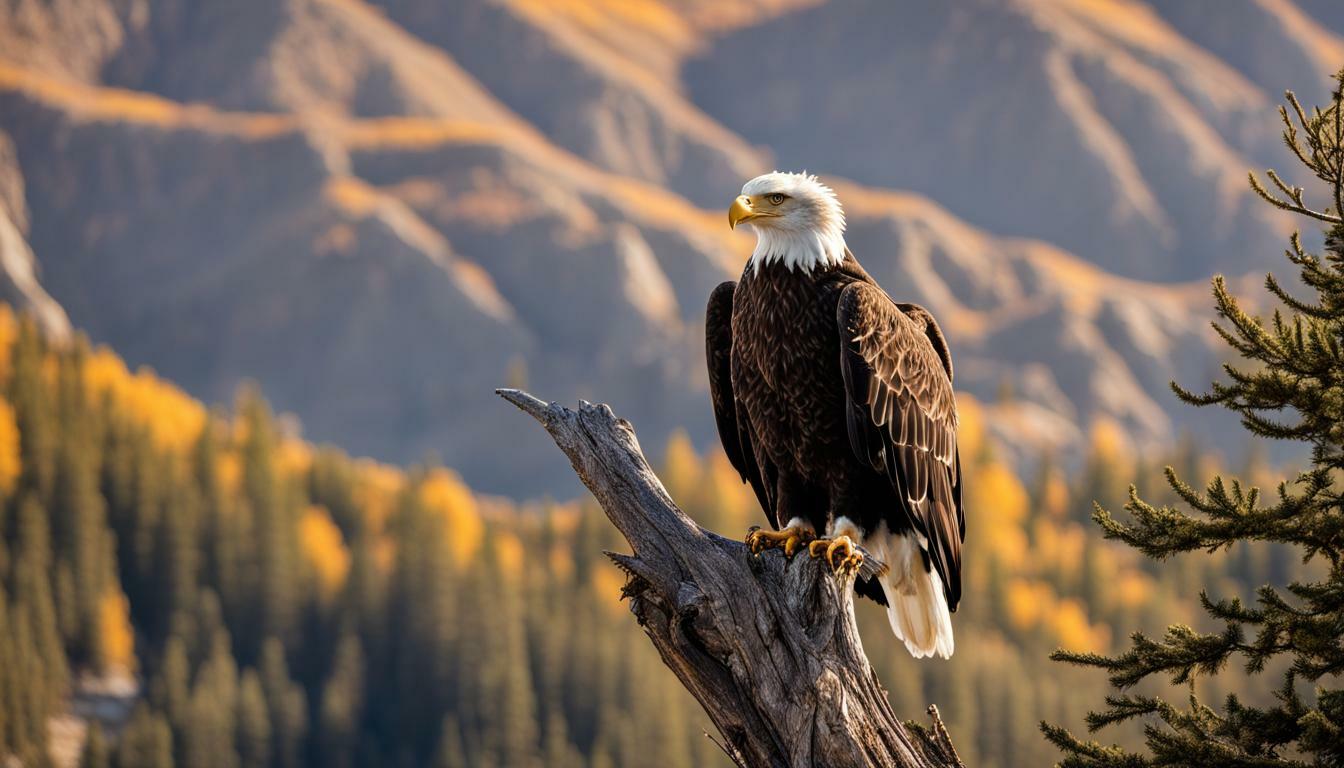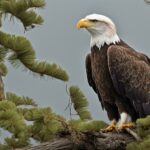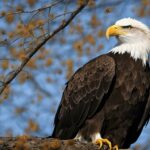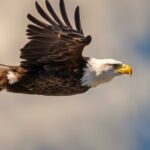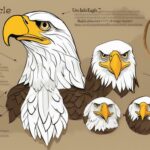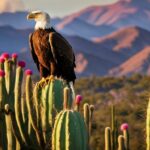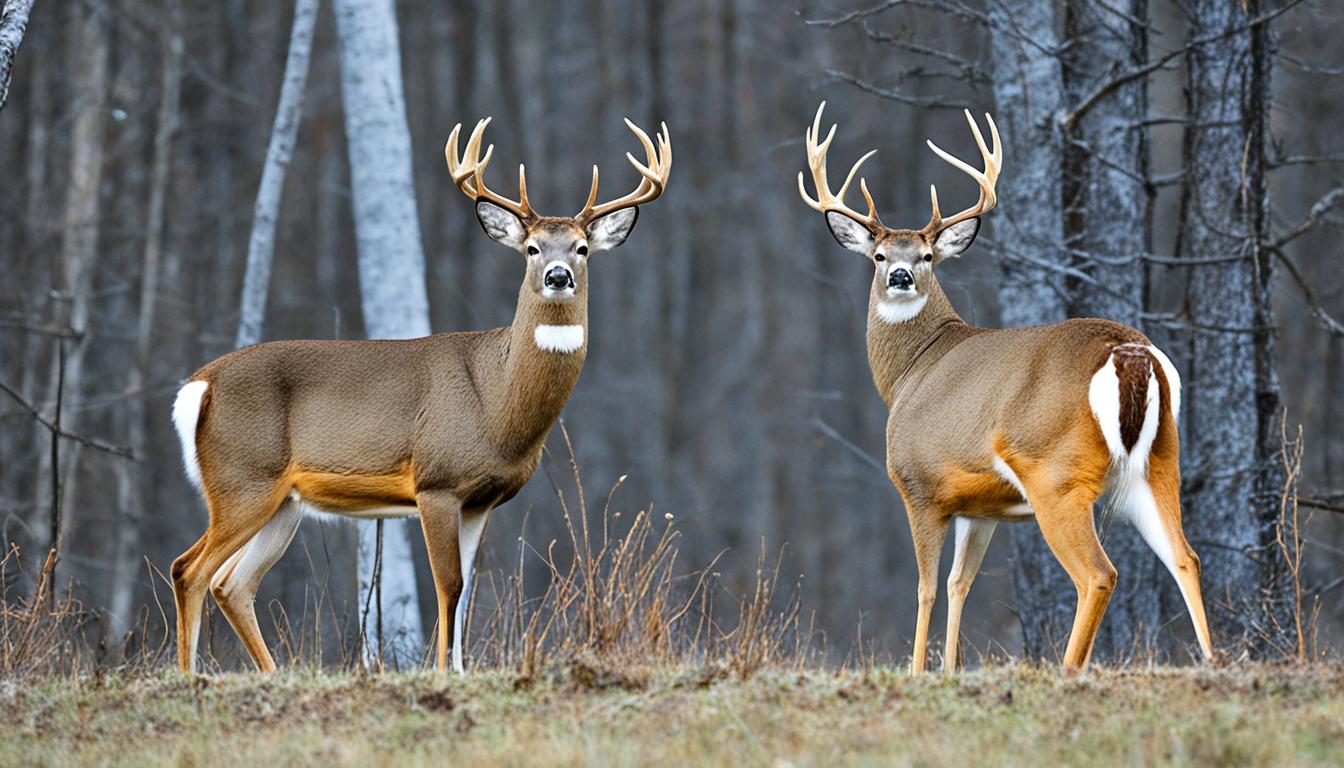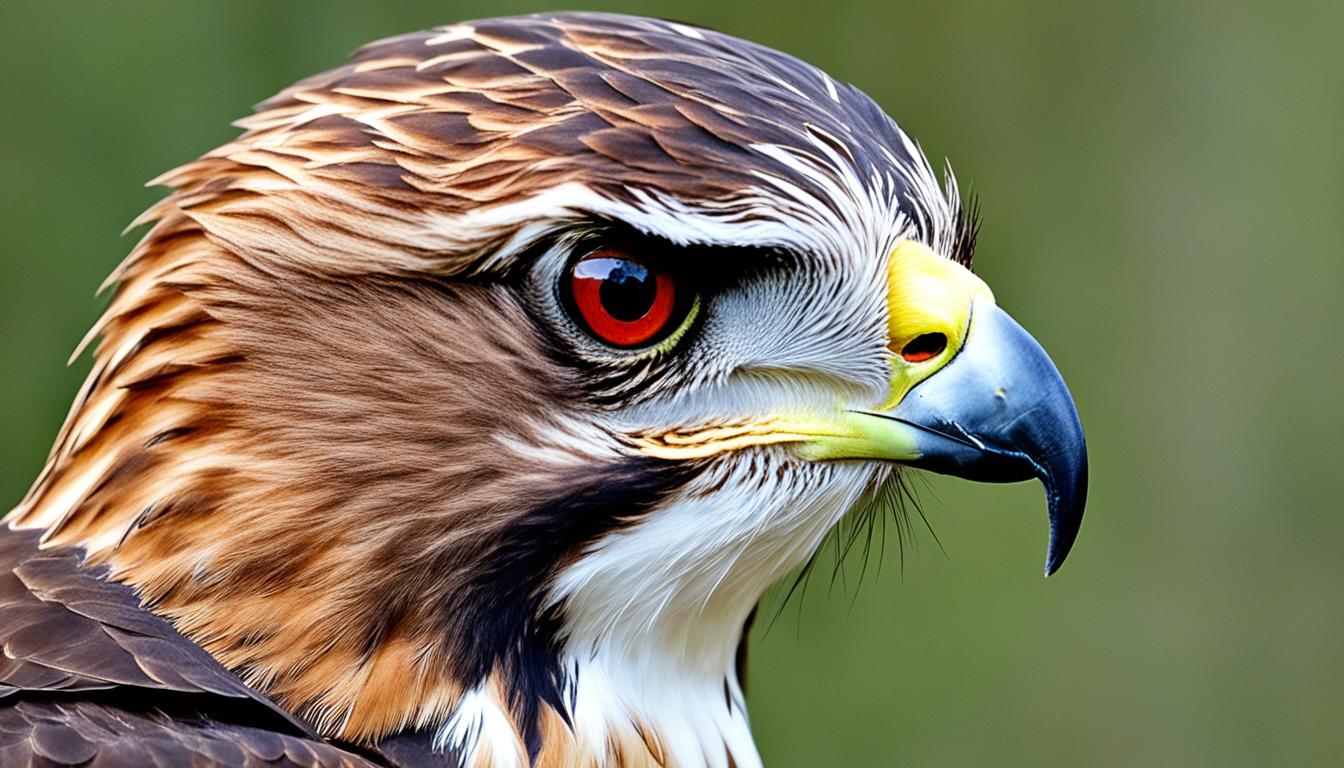Have you ever wondered if bald eagles are rare to see? These majestic birds are undoubtedly unique and awe-inspiring, but are they a common sight in the wild? In this article, we’ll explore the rarity of bald eagle sightings, their habitats, breeding and migration patterns, conservation efforts, and more. By the end, you’ll have a greater appreciation for these magnificent creatures and an understanding of what it takes to protect their populations.
Key Takeaways:
- Bald eagles are a rare and majestic sight due to their symbolic importance as the national bird of the United States.
- Conservation efforts have helped bald eagle populations recover from being listed as an endangered species.
- You can increase your chances of spotting bald eagles by visiting their preferred habitats and understanding their breeding and migration patterns.
- Protecting the habitats of bald eagles is crucial to ensuring their continued presence in the wild.
The Symbolic Bald Eagle: A Rare and Majestic Sight
If you’re lucky enough to spot a bald eagle in the wild, it’s an experience you won’t soon forget. The bald eagle’s significance as the national bird of the United States has contributed to its perception as a rare and majestic creature.
The bald eagle also holds a symbolic place in American culture, representing freedom, strength, and independence. Its image is featured on the Great Seal of the United States, the Presidential flag, and in countless works of art and literature.
And yet, for all its cultural significance, seeing a bald eagle in the wild remains a rare and thrilling experience. Their elusive nature and preference for remote habitats such as forests, lakes, and rivers, make sightings all the more special.
But despite their scarcity, bald eagles have made a remarkable recovery in recent decades, thanks to the efforts of conservationists and wildlife enthusiasts. So if you do happen to see a bald eagle in the wild, consider it a fortunate and unforgettable encounter with one of America’s most beloved and iconic creatures.
The Bald Eagle Habitat: Where Can You Find Them?
Have you ever wondered where you can find bald eagles in the wild? Bald eagles are commonly found in the United States, and their habitats can provide excellent opportunities for sightings.
Bald eagles prefer coastal areas, lakes, and rivers, where they can easily find food. They often nest in tall trees near bodies of water, providing a good vantage point from which to hunt for fish.
| Location | Habitat |
|---|---|
| Alaska | Tundra, coastal areas |
| Florida | Coastal areas, wetlands |
| Washington | Forest, coastal areas |
| Minnesota | Lakes, wetlands |
Some of the best places to spot bald eagles include national parks such as Yellowstone, Glacier, and Grand Teton, as well as wildlife reserves and sanctuaries such as the Chilkat Bald Eagle Preserve in Alaska.
Keep in mind that bald eagles are protected by law, and it is illegal to hunt, injure, or disturb them or their nests. It is important to observe these magnificent creatures from a safe distance, not interrupting their natural behaviors.
Now that you know where to find bald eagles, prepare for an unforgettable wildlife watching experience.
Population Recovery: From Endangered to Thriving
You may be surprised to learn that bald eagle populations were once in danger of extinction. Due to factors such as habitat loss, hunting, and pesticide use, their numbers dwindled to a mere 417 nesting pairs by 1963. This led to their classification as an endangered species and the implementation of conservation efforts to protect their habitats and prevent further declines in their populations.
Thanks to these efforts, bald eagle populations have made a remarkable comeback. As of 2021, there are an estimated 316,700 bald eagles in the United States, a significant increase from their low point in the 1960s.
| Year | Population |
|---|---|
| 1963 | 417 nesting pairs |
| 2007 | 9,789 nesting pairs |
| 2021 | 316,700 total bald eagles |
The success of bald eagle conservation efforts can be attributed to various actions, including habitat protection, pesticide regulation, and public awareness campaigns. The Bald and Golden Eagle Protection Act of 1940, which prohibits the hunting, killing, or capturing of bald eagles, has also played a significant role in their population recovery.
Despite their recovery, bald eagles still face threats such as habitat loss and pollution. It is important to continue conservation efforts to ensure their continued population growth and protection.
“Saving the bald eagle was an important conservation success story. It was one of the first species to be listed under the Endangered Species Act, and the symbol of the bald eagle was a rallying cry for conservationists across the country.”
Breeding and Migration Patterns: Annual Opportunities for Sightings
If you’re wondering how often you might be able to spot a bald eagle, it’s important to understand their breeding and migration patterns. Bald eagles generally breed in the winter months, from December to March, and lay their eggs in February or March. The young eaglets will remain in the nest for several months before taking their first flight. This nesting period provides a great opportunity for eagle sightings.
During the summer months, bald eagles can be harder to spot as they tend to migrate to cooler areas in the north. However, in the fall, they return to their summer homes, presenting another chance for sightings.
Another factor affecting bald eagle sightings is their feeding habits. Bald eagles primarily feed on fish, so areas with a large fish population are more likely to attract them. You may have luck spotting them near rivers, lakes, or coastal areas.
If you’re interested in seeing bald eagles in action during their breeding and nesting period, be sure to check out some of the many eagle-watching events that take place across the United States. These events are typically held from December to April and offer a great opportunity to see these majestic birds up close.
A Thrill for Birdwatchers: Where and How to Spot Bald Eagles
If you’re eager to catch sight of a bald eagle in the wild, there are plenty of locations across the United States where you can increase your chances of spotting one. Coastal areas, lakes, and rivers are prime spots to keep an eye out for these majestic birds.
If you’re planning a trip, consider visiting national parks and wildlife reserves that offer opportunities for bald eagle sightings. Some popular locations include the Chilkat Bald Eagle Preserve in Alaska, the Mississippi River in Missouri, and Lake Coeur d’Alene in Idaho.
The best times of year to spot bald eagles vary depending on your region. In general, winter is a great time to see them because they congregate around open water, making them easier to spot. Fall and spring are also good times because of their migratory patterns.
When you’re on the lookout for a bald eagle, be patient and keep your eyes peeled. Look for their distinctive white head and tail feathers, which make them easy to spot against a blue sky or over water. You may also hear their distinctive high-pitched call before you see them.
If you’re lucky enough to spot a bald eagle, be respectful and keep your distance. It’s important to avoid disturbing their habitat or interfering with their natural behaviors. Observing them from a distance with binoculars or a camera is the best way to enjoy these amazing creatures while respecting their space.
Bald Eagle Conservation Efforts: Protecting Their Habitat
If you want to continue to see bald eagles in the wild, it’s crucial to support conservation efforts that protect their habitats. Due to habitat loss, pollution, and human interference, the scarcity of bald eagles can become a reality. By supporting initiatives that preserve their environment and promote responsible tourism, you can help ensure the continued presence of these magnificent creatures.
| Ways to support conservation efforts: |
|---|
| Donate: Consider making a donation to a wildlife conservation organization dedicated to protecting bald eagles and their habitats. |
| Volunteer: Get involved in conservation efforts by volunteering with an organization that supports the preservation of bald eagles. |
| Reduce your carbon footprint: Decrease your impact on the environment by reducing your use of plastic, using public transportation or carpooling, and conserving water and energy. |
Protecting the habitat of bald eagles benefits not only these majestic birds but also the ecosystem in which they live. By preserving their habitats, we ensure that other wildlife, such as fish and other bird species, have a secure environment to thrive.
Remember, supporting conservation efforts is crucial to maintain the rarity and uniqueness of bald eagles, and to ensure that future generations have the opportunity to appreciate these magnificent creatures in the wild.
The Thrill of Eagle Spotting: Tales from Enthusiasts
There’s nothing quite like the excitement of spotting a bald eagle in the wild. For many birdwatchers and nature enthusiasts, the chance to see these majestic creatures up close is a thrill like no other. Here are some stories from eagle enthusiasts:
“I’ve been an avid birdwatcher for years, and spotting a bald eagle was always high on my list. Finally, last year, while hiking in a national park, I saw one perched on a tree branch. It was a breathtaking sight and a moment I’ll never forget.”
For some, eagle spotting is a family tradition:
“My grandfather used to take me on hikes to spot bald eagles when I was a kid. Now, as an adult, I do the same with my own children. Seeing these birds soar through the sky is a reminder of the beauty and power of nature.”
Others have made it their mission to spot as many eagles as possible:
“I’m part of a birdwatching club, and we organize trips specifically to spot bald eagles. We’ve traveled all over the country, and it’s always a thrill when we finally see one. I’ve never tired of seeing these magnificent birds in the wild.”
Whether you’re an experienced birdwatcher or simply someone who appreciates nature’s beauty, spotting a bald eagle is an unforgettable experience. So pack your binoculars and head out to the great outdoors – you never know what you might see!
Conservation Challenges: Threats to the Bald Eagle Population
While the bald eagle has made a remarkable recovery from being listed as an endangered species, its population still faces several threats. These majestic birds require healthy habitats and safe surroundings to thrive, but various factors can put them at risk.
One of the primary challenges faced by bald eagles is habitat loss. Development and human activity in their preferred areas, such as coastal regions and wetlands, can disrupt their nesting and feeding patterns. Additionally, pollution can affect the quality of water and food sources, harming the birds and their offspring.
Human interference can also pose a threat to the bald eagle population. Nest disturbance, hunting, and collisions with power lines and wind turbines can cause injury or death to these birds. As eagles are at the top of the food chain, they are also vulnerable to the bioaccumulation of toxins and pollutants, which can affect their health and reproductive abilities.
Climate change is another looming threat to the bald eagle population. As temperatures rise and weather patterns shift, it can impact their breeding and migration patterns, affecting the availability of food and habitat. Extreme weather events, such as storms or droughts, can also harm their populations.
Efforts are underway to combat these challenges and protect the bald eagle population. Conservation initiatives aim to preserve their habitats and mitigate human impact, while education programs raise awareness about their importance and vulnerability. It is essential to continue these efforts to ensure that future generations can encounter and appreciate the rare and majestic sight of a bald eagle in the wild.
Future Perspectives: Ensuring the Continued Presence of Bald Eagles
Now that you’ve learned about the beauty and rarity of bald eagles, it’s time to take action to protect these magnificent birds. As human activity increasingly impacts their habitats, we must ensure their continued presence for future generations to appreciate. Here are some important steps you can take:
- Support conservation efforts: Consider donating to organizations that support the conservation of bald eagles and their habitats. Even small contributions can make a big difference in protecting these birds from endangerment and extinction.
- Practice responsible tourism: When visiting areas where bald eagles reside, be mindful of your impact on their habitats. Avoid disturbing their habitat or nesting sites, and follow guidelines and regulations set by park rangers or wildlife officials.
- Reduce your carbon footprint: Climate change poses a significant threat to bald eagles and their habitats. You can help reduce this threat by making lifestyle choices that reduce your carbon footprint. Consider prioritizing energy-efficient products, reducing car usage, and consuming less meat.
- Spread awareness: Educate others about the importance of bald eagles and the threats they face. Share your knowledge and experiences with family, friends, and colleagues to inspire action and support for conservation efforts.
Protecting the Future of Bald Eagles
By taking these steps, you can help ensure that bald eagles continue to soar in the skies for years to come. With sufficient support and conservation efforts, we can protect these birds and their habitats, allowing us to witness their beauty and majesty for generations to come.
Conclusion
Congratulations! You have discovered the uniqueness and importance of bald eagles today. Although they were once endangered, conservation efforts have allowed their populations to recover and thrive. While sightings may have once been rare, the habitats and behaviors of bald eagles provide annual opportunities for eagle spotting.
The future of bald eagles depends on continued conservation efforts and responsible tourism. By preserving their habitats and supporting conservation initiatives, you can help ensure the continued presence of these majestic birds.
Let’s take a moment to appreciate the beauty and significance of bald eagles and do our part in protecting them for generations to come.
Are Bald Eagles Native to Colorado and is it Rare to See Them There?
Yes, bald eagles in colorado are native to the state. However, seeing them there is not rare anymore. With successful conservation efforts, their population has rebounded, making sightings more common. These majestic birds can be observed soaring over Colorado’s lakes, rivers, and mountains, adding to the state’s natural beauty.
FAQ
Q: Are bald eagles rare to see?
A: No, bald eagles are not rare to see. While they were once endangered, their population has significantly recovered, and they can be found in various parts of the United States.
Q: Where can you find bald eagles?
A: Bald eagles can be commonly found near coastal areas, lakes, and rivers. They prefer habitats with abundant fish and large trees for nesting.
Q: How often do bald eagles appear?
A: Bald eagles have breeding and migration patterns that vary throughout the year. Spring and fall are often the best times to spot them, but they can be seen in certain areas year-round.
Q: How can I spot bald eagles in the wild?
A: To spot bald eagles, consider visiting national parks, wildlife reserves, or areas known for their bald eagle populations. Look for their large nests in tall trees near bodies of water.
Q: What are the threats to the bald eagle population?
A: Threats to bald eagles include habitat loss, pollution, and human interference. Conservation efforts are crucial to protect their habitats and ensure their continued presence.
Q: How can I support bald eagle conservation efforts?
A: You can support bald eagle conservation efforts by educating others about their importance, participating in local conservation initiatives, and practicing responsible tourism in their habitats.

